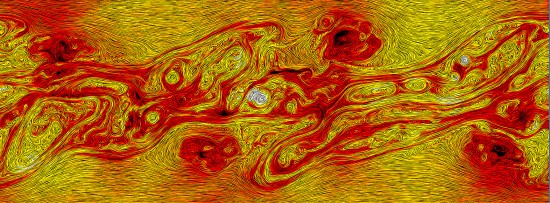Apr 8, 2016
New Horizons measures solar wind heating far from the Sun.
As written previously, the Electric Sun theory sees the Sun as an anode, or or positively charged “electrode.” The cathode, called the heliosphere, is located billions of kilometers from its surface. This is the double layer that isolates the Sun’s plasma cell from galactic plasma, called the Interstellar Medium.
Most of the voltage difference between the Sun and the galaxy occurs across that heliospheric boundary sheath. Inside, a weak electric field centered on the Sun is enough to power the solar discharge. The visible component of that discharge occurs above the solar surface in double layers.
At 500 kilometers above the surface, the “coldest” temperature exists: 4400 Kelvin. This region is known as the photosphere. 2200 kilometers up, the temperature rises to about 20,000 Kelvin. It then jumps by hundreds of thousands of Kelvin, slowly continuing to rise, eventually reaching 2 million Kelvin in the corona. The Sun’s reverse temperature gradient supports a glow discharge model, but contradicts nuclear fusion processes.
According to a recent press release, the New Horizons spacecraft detected “significant changes in how the solar wind behaves far from the Sun”.
The discovery that a solar wind escapes the Sun at 700 kilometers per second (its fastest speed) was a surprise to early research. In a gravity-driven Universe, the Sun’s heat and radiation pressure are not enough to explain how solar wind particles accelerate past Venus and Earth.
New Horizons found that solar wind variations can “smooth out” as distance from the Sun increases. Dr. Heather Elliott, a principal scientist in SwRI’s Space Science and Engineering Division, said:
“Differences in speed and density average together as the solar wind moves out, but the wind is still being heated as it travels and faster wind runs into slower wind, so you see evidence of the Sun’s rotation pattern in the temperatures even in the outer solar system.”
An electric field, focused on the Sun, accelerates charged particles: the faster they accelerate, the stronger the field. As noted, however, the interplanetary electric field is extremely weak, but the solar wind acceleration over tens of millions of kilometers does confirm the Sun’s electric field, enough to sustain a drift current across the Solar System. Within that spatial volume, the implied charge flow is sufficient to power the Sun.
In the Electric Universe, where electric stars are dominant, “anomalous heating” of the solar wind is explained by the Sun’s electric field. The easiest way for charged particles to accelerate is within such a field. Since the Sun’s influence extends for billions of kilometers, ending at the heliospheric boundary, the acceleration (heating) of positively charged solar wind particles is an electrical phenomenon that is predicted by the Electric Sun model.
Stephen Smith













